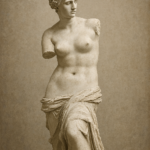
Venus de Milo
Few works of art have captured the imagination of the world quite like the Venus de Milo. This ancient Greek masterpiece, carved over two millennia ago, stands as a timeless symbol of beauty, mystery, and artistic genius. Discovered on a remote Aegean island and now displayed in the Louvre Museum, the statue’s graceful form and enigmatic missing arms have made it one of the most iconic sculptures in history. But beyond its fame lies a fascinating story filled with historical intrigue, cultural significance, and artistic innovation. In this post, we’ll explore 25 captivating facts about Venus de Milo—from its origins in the Hellenistic period to its enduring influence on modern art and pop culture. Whether you’re an art enthusiast or simply curious about the secrets behind this legendary figure, these insights will deepen your appreciation for one of the greatest treasures of antiquity.
1. Venus de Milo as Aphrodite
The Venus de Milo is widely recognized as a representation of Aphrodite, the Greek goddess of love and beauty, which immediately places it within the pantheon of classical mythology. Aphrodite was one of the most celebrated deities in ancient Greek culture, often associated with ideals of physical perfection and divine allure. Sculptures of Aphrodite were common in sanctuaries and public spaces, serving both religious and aesthetic purposes. The Venus de Milo’s serene facial expression and graceful posture embody these ideals, making it a quintessential example of how Greek art sought to merge divine attributes with human form. This connection to Aphrodite also explains why the statue became an enduring symbol of beauty in Western art history.
2. Hellenistic Period Origins
Created during the Hellenistic period, around 130–100 BCE, the Venus de Milo reflects a time when Greek art was evolving beyond the rigid forms of the Classical era. The Hellenistic age was characterized by increased realism, emotional expression, and dynamic movement in sculpture. Artists experimented with more naturalistic poses and intricate drapery, aiming to capture the complexity of human experience. The Venus de Milo exemplifies these trends through its contrapposto stance and flowing garments, which suggest both elegance and vitality. This period also saw the spread of Greek culture across the Mediterranean, influencing art in regions as far as Egypt and Asia Minor.
3. Crafted from Parian Marble
The statue is carved from Parian marble, a material prized in antiquity for its fine grain and luminous quality. Quarried on the island of Paros, this marble was favored by Greek sculptors for its ability to hold delicate details and its smooth, almost translucent finish. The choice of Parian marble for the Venus de Milo underscores the importance of material in achieving aesthetic perfection. Its subtle glow enhances the lifelike appearance of the figure, while the durability of the stone has allowed the sculpture to survive for over two millennia. This material choice also signals the high status of the work, as Parian marble was reserved for significant commissions.
4. Monumental Height
Standing at approximately 204 cm (6 ft 8 in), the Venus de Milo commands attention through its monumental scale. This height was deliberate, intended to create an imposing presence whether displayed in a sanctuary or a public space. Large-scale sculptures were common in the Hellenistic period, as they conveyed grandeur and divine authority. The towering figure of Aphrodite would have inspired awe among ancient viewers, reinforcing her status as a goddess. Today, its size continues to impress visitors at the Louvre, where it dominates its gallery and draws millions of admirers annually.
5. Housed in the Louvre Museum
The Venus de Milo resides in the Louvre Museum in Paris, one of the world’s most prestigious cultural institutions. Since its arrival in the early 19th century, the statue has become a centerpiece of the museum’s collection, attracting scholars, artists, and tourists alike. Its placement in the Louvre elevated its status from an archaeological find to a global icon of beauty. The museum’s efforts to preserve and display the sculpture have ensured its continued influence on art and culture, making it one of the most photographed and studied works in history.
6. Discovered in 1820
The statue’s discovery in 1820 on the island of Milos was a pivotal moment in the history of archaeology. At the time, Europe was experiencing a surge of interest in classical antiquity, fueled by the Romantic movement and archaeological expeditions. The unearthing of the Venus de Milo captured public imagination, as it seemed to embody the lost grandeur of ancient Greece. Its discovery also sparked debates among scholars regarding its origins, date, and meaning, many of which continue to this day.
7. Found by a Farmer
The Venus de Milo was found by a farmer named Yorgos Kentrotas while he was digging on his land. This humble beginning contrasts sharply with the statue’s later fame, illustrating how chance discoveries can alter the course of art history. Kentrotas’s find quickly attracted the attention of local officials and foreign diplomats, leading to negotiations that ultimately brought the statue to France. The story of its discovery adds a layer of intrigue to its legacy, reminding us that even the most celebrated artworks can emerge from unexpected circumstances.
8. Unearthed in Pieces
When discovered, the Venus de Milo was not intact but in several fragments, including the torso and separate sections of drapery. This fragmented state posed challenges for restoration and interpretation, as scholars had to reconstruct its original appearance from incomplete evidence. The missing arms became a defining feature of the statue, fueling speculation about their original position and what objects they might have held. These gaps in knowledge have contributed to the statue’s mystique, inviting endless theories and artistic reconstructions.
9. Acquired by French Diplomacy
The statue was acquired by the French ambassador to Turkey, who recognized its artistic value and arranged for its transport to France. This diplomatic maneuver reflects the intense competition among European powers to secure classical antiquities during the 19th century. Possessing such treasures was seen as a mark of cultural superiority, and the Venus de Milo became a symbol of France’s commitment to preserving and celebrating ancient art. Its acquisition also highlights the complex interplay between archaeology, politics, and national pride.
10. Gifted to King Louis XVIII
After its arrival in France, the Venus de Milo was presented to King Louis XVIII, who subsequently donated it to the Louvre Museum. This act of royal patronage ensured the statue’s public accessibility and cemented its status as a national treasure. The king’s gesture was part of a broader effort to restore France’s cultural prestige following the upheavals of the Napoleonic era. By placing the Venus de Milo in the Louvre, Louis XVIII contributed to the democratization of art, allowing people from all walks of life to admire a masterpiece of antiquity.
11. Missing Arms and Their Mystery
One of the most intriguing aspects of the Venus de Milo is its missing arms, which have become a defining feature of the statue’s identity. When the sculpture was discovered, the arms were already absent, and despite extensive searches, they were never recovered. This absence has sparked centuries of speculation among historians and artists about what the original pose might have been. Some theories suggest that Aphrodite was holding an apple, referencing the mythological Judgment of Paris, while others propose she held a mirror or drapery. The mystery surrounding the missing limbs adds an element of enigma that has arguably amplified the statue’s fame, making it not just a masterpiece of antiquity but also a puzzle that continues to captivate scholars and the public alike.
12. Lost Inscription and Attribution
Early reports indicate that the statue’s original base bore an inscription naming Alexandros of Antioch as the sculptor, but this base was lost shortly after its discovery. The absence of definitive evidence has led to debates about authorship, with some attributing the work to Praxiteles or his school. However, stylistic analysis supports the attribution to Alexandros, who was active during the late Hellenistic period. The loss of the inscription underscores the fragility of archaeological context and how missing details can shape art historical narratives. This uncertainty has fueled scholarly discourse, making the Venus de Milo not only an object of beauty but also a subject of ongoing research.
13. Semi-Nude Drapery
The statue’s semi-nude appearance, with drapery cascading around the hips, exemplifies the Hellenistic fascination with sensuality and realism. Unlike earlier Classical representations of Aphrodite, which often emphasized modesty, the Venus de Milo embraces a more daring aesthetic. The intricate folds of the garment contrast with the smoothness of the exposed torso, creating a dynamic interplay of textures. This treatment of clothing as both a covering and a compositional element reflects the technical mastery of Hellenistic sculptors, who sought to evoke movement and drama in their works.
14. Contrapposto Stance
The Venus de Milo’s contrapposto stance—a pose where the weight rests on one leg while the other is relaxed—was a hallmark of Greek sculpture, introduced during the Classical period and perfected in the Hellenistic era. This posture imparts a sense of naturalism and fluidity, breaking away from rigid, frontal poses. The subtle twist of the torso and the gentle tilt of the head create an impression of grace and spontaneity, as if the goddess were caught in a moment of quiet reflection. This dynamic composition demonstrates the artist’s skill in balancing anatomical accuracy with aesthetic harmony.
15. Head Turn and Expression
The slight turn of the head in the Venus de Milo adds to its lifelike quality, suggesting movement and emotional depth. Her serene expression, devoid of overt emotion, invites contemplation and interpretation. This ambiguity aligns with Greek ideals of beauty, which favored restraint and balance over dramatic gestures. The calm demeanor of Aphrodite contrasts with the sensuality of her pose, creating a tension that has fascinated viewers for centuries. This interplay of subtlety and allure exemplifies the sophistication of Hellenistic art.
16. Idealized Beauty of the Era
The Venus de Milo embodies the idealized beauty of the late Hellenistic period, characterized by harmonious proportions and refined features. Greek artists of this era sought to transcend mere physical likeness, aiming instead to capture an ideal that combined naturalism with perfection. The statue’s elongated limbs, smooth contours, and symmetrical facial features reflect this pursuit of an unattainable ideal. Such representations were not merely decorative but carried philosophical implications, expressing concepts of order, balance, and divine harmony.
17. Intended for a Sanctuary
Scholars believe the Venus de Milo was originally intended for a sanctuary or public space dedicated to Aphrodite. In ancient Greece, statues of deities served both religious and civic functions, reinforcing communal values and offering a focal point for worship. The scale and craftsmanship of the Venus de Milo suggest it was a prestigious commission, possibly funded by a wealthy patron or a city-state. Its placement in a sacred context would have enhanced its aura of divinity, inviting devotees to contemplate the goddess’s attributes.
18. Blend of Classical and Hellenistic Styles
The Venus de Milo represents a synthesis of Classical and Hellenistic styles, combining the idealized forms of the former with the expressive realism of the latter. While its proportions and serene expression recall Classical prototypes, its dynamic pose and intricate drapery reflect Hellenistic innovations. This fusion illustrates the continuity and evolution of Greek art, as artists adapted traditional motifs to new aesthetic sensibilities. The statue thus serves as a bridge between two artistic epochs, embodying the best of both worlds.
19. Speculation About Original Attributes
The absence of the statue’s arms has led to numerous reconstructions and hypotheses about its original attributes. Some scholars argue that Aphrodite held an apple, referencing her role in the Judgment of Paris, while others suggest a mirror, symbolizing vanity and beauty. These conjectures are based on literary sources and comparisons with other sculptures. The uncertainty surrounding these details has transformed the Venus de Milo into a canvas for imagination, inspiring artists and writers to propose their own interpretations.
20. Influence of Praxiteles
The Venus de Milo shows clear stylistic affinities with works by Praxiteles, a renowned sculptor of the 4th century BCE. Praxiteles was celebrated for his sensuous depictions of Aphrodite, which set a precedent for later representations. The soft modeling of flesh, the graceful pose, and the interplay of nudity and drapery in the Venus de Milo echo Praxitelean aesthetics, albeit with a Hellenistic twist. This lineage underscores the enduring influence of Classical masters on subsequent generations of artists.
21. Symbol of Classical Beauty
Since its rediscovery, the Venus de Milo has become an emblem of classical beauty, shaping Western standards of aesthetics. Its harmonious proportions and serene expression have been cited in treatises on art and anatomy, serving as benchmarks for artistic training. The statue’s fame has transcended scholarly circles, permeating popular culture and advertising. It has been reproduced in countless forms, from plaster casts to postcards, reinforcing its status as an icon of timeless elegance.
22. Reproductions and Cultural References
The Venus de Milo has inspired a vast array of reproductions and cultural references, appearing in literature, film, and even cartoons. Its image has been appropriated for commercial purposes, from perfume bottles to fashion campaigns, attesting to its versatility as a symbol of beauty. Artists such as Salvador Dalí and René Magritte have reinterpreted the statue in surrealist contexts, challenging conventional notions of perfection. These adaptations demonstrate the statue’s enduring relevance and capacity to generate new meanings across different media.
23. Fame in the 19th Century
The Venus de Milo achieved international fame in the 19th century, becoming a centerpiece of the Louvre’s collection. Its arrival coincided with a surge of interest in classical antiquity, fueled by archaeological discoveries and Romantic ideals. The statue was celebrated in art journals, exhibited in world fairs, and studied by academicians, cementing its reputation as a masterpiece. This period also saw the rise of art tourism, with the Venus de Milo serving as a must-see attraction for travelers to Paris.
24. Presence in Pop Culture
Beyond scholarly discourse, the Venus de Milo has permeated popular culture, appearing in films, advertisements, and even comic strips. Its distinctive silhouette, with missing arms, has been parodied and reimagined in humorous contexts, making it one of the most recognizable artworks in the world. These playful appropriations testify to the statue’s iconic status and its ability to resonate with audiences across generations. Whether revered or satirized, the Venus de Milo remains a fixture in the cultural imagination.
25. Enduring Legacy Despite Incompleteness
Despite its incomplete state, the Venus de Milo continues to captivate viewers and scholars alike, proving that perfection is not a prerequisite for greatness. Its missing arms, far from diminishing its appeal, have contributed to its mystique and allure. The statue embodies the paradox of fragility and permanence, reminding us that beauty can endure even in the face of loss. As a testament to the artistic achievements of ancient Greece, the Venus de Milo stands as a timeless symbol of human creativity and aspiration.
Frequently Asked Questions (FAQs) About Venus de Milo
1. What is the Venus de Milo?
The Venus de Milo is an ancient Greek marble statue believed to represent Aphrodite, the goddess of love and beauty (known as Venus in Roman mythology). It is considered one of the most famous sculptures in the world and a masterpiece of Hellenistic art, celebrated for its elegance, idealized proportions, and enigmatic missing arms. Today, it stands as a symbol of classical beauty and artistic perfection. [en.wikipedia.org]
2. When was the Venus de Milo created?
The statue was sculpted during the Hellenistic period, most likely between 130 and 100 BCE. This era followed the Classical period and was marked by increased realism, dynamic poses, and expressive details in art. The Venus de Milo reflects these characteristics through its graceful contrapposto stance and intricate drapery. [en.wikipedia.org]
3. Who created the Venus de Milo?
The sculptor is widely believed to be Alexandros of Antioch, based on a now-lost inscription found near the statue. However, this attribution remains debated among scholars. Earlier theories suggested Praxiteles, a Classical sculptor, but stylistic evidence supports Alexandros as the creator. [britannica.com]
4. Where was the Venus de Milo discovered?
The statue was discovered in 1820 on the Greek island of Milos (also called Melos) in the Aegean Sea. A local farmer named Yorgos Kentrotas unearthed the statue while clearing his field. French naval officer Olivier Voutier witnessed the discovery and helped bring the statue to international attention. [broaden-horizons.fr]
5. Why is it called “Venus de Milo”?
The name combines Venus, the Roman equivalent of Aphrodite, and de Milo, meaning “of Milos,” the island where it was found. The Louvre Museum adopted this name after acquiring the statue, emphasizing its connection to both classical mythology and its geographic origin. [worldhistoryedu.com]
6. Where is the Venus de Milo now?
The statue has been housed in the Louvre Museum in Paris since 1821. It is one of the museum’s most visited and photographed artworks, alongside the Mona Lisa and Winged Victory of Samothrace. [en.wikipedia.org]
7. How tall is the Venus de Milo?
The statue measures approximately 204 cm (6 ft 8 in) in height, making it slightly larger than life-size. Its monumental scale was intended to convey grandeur and divine presence. [en.wikipedia.org]
8. What material is the Venus de Milo made of?
It is carved from Parian marble, a fine-grained, luminous stone sourced from the island of Paros. This material was highly prized in antiquity for its ability to capture delicate details and smooth finishes. [art-guides.com]
9. Why are the arms missing?
The Venus de Milo was discovered without arms, and their original position remains unknown. Scholars speculate that she may have held an apple (symbolizing the Judgment of Paris), a mirror, or a shield. The mystery of the missing arms has become part of the statue’s allure and cultural identity. [greecehigh…nition.com]
10. Was the Venus de Milo originally painted?
Like many ancient Greek sculptures, it is possible that the Venus de Milo was originally painted or adorned with jewelry. However, no definitive traces of pigment remain, and most of its surface appears polished marble. [en.wikipedia.org]
11. Is the Venus de Milo complete?
No. In addition to missing arms, the statue lacks its original base, left foot, and earlobes. Despite these losses, its overall condition is remarkably good for a sculpture over 2,000 years old. [en.wikipedia.org]
12. What does the Venus de Milo symbolize?
The statue symbolizes idealized beauty, love, and sensuality, reflecting Greek cultural values. Its serene expression and graceful pose embody the philosophical concept of harmony and proportion central to Greek aesthetics. [greekhistoryhub.com]
13. Why is the Venus de Milo so famous?
Its fame stems from a combination of factors: its artistic excellence, mysterious incompleteness, and its role as a cultural icon. Since its arrival at the Louvre, it has inspired poets, painters, and modern artists, appearing in literature, advertising, and even cartoons. [newworlden…opedia.org]
14. How was the Venus de Milo transported to France?
After its discovery, French officials negotiated its purchase and shipped it to France in 1821. It was presented to King Louis XVIII, who donated it to the Louvre Museum. [broaden-horizons.fr]
15. Is there any controversy about its identity?
Yes. While most scholars identify the statue as Aphrodite, some argue it could represent Amphitrite, a sea goddess worshipped on Milos. This theory arises from the statue’s island origin and certain stylistic features. [worldhistoryedu.com]
16. How does the Venus de Milo compare to other famous sculptures?
The Venus de Milo is often compared to Michelangelo’s David and Winged Victory of Samothrace for its monumental scale and influence. Unlike David’s heroic masculinity, Venus emphasizes feminine grace and sensuality. [greekhistoryhub.com]
17. Has the Venus de Milo influenced modern art?
Absolutely. It inspired over 70 poems, influenced 19th-century academic art, and later appeared in Surrealist works by artists like Salvador Dalí. Its image has been widely reproduced in photography, advertising, and pop culture. [newworlden…opedia.org]
18. What is the estimated value of the Venus de Milo?
The statue is considered priceless due to its historical and cultural significance. It is one of the Louvre’s most valuable treasures, and its worth cannot be measured in monetary terms. [en.wikipedia.org]
19. Can visitors see the Venus de Milo today?
Yes. It is displayed prominently in the Louvre’s Galerie des Antiques, where millions of visitors view it each year. Photography is allowed, making it one of the most photographed artworks globally. [broaden-horizons.fr]
20. Why does the Venus de Milo continue to fascinate people?
Its enduring appeal lies in its combination of perfection and mystery. The missing arms invite speculation, while its serene beauty evokes timeless ideals. This duality makes it not just a sculpture, but a cultural phenomenon that transcends centuries. [greecehigh…nition.com]









